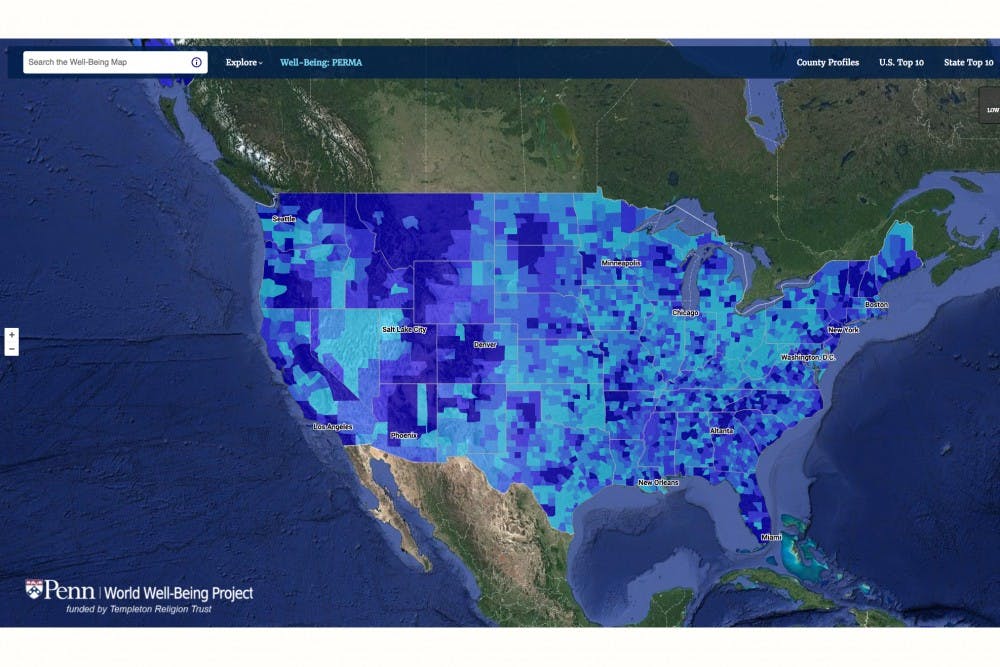
Penn researchers are using social media to measure mental well-being across the country.
A collaborative effort between psychologists and computer scientists, the Penn World Well-Being Project analyzes millions of Facebook and Twitter posts to predict geographic variations in personality, life satisfaction and mortality rates.
Penn Computer and Information Science professor Lyle Ungar, a principle investigator for the WWBP, said that one of the project’s goals is to use social media to measure and identify the components of emotional well-being, such as happiness, relationships and quality of life.
Martin Seligman, a professor of psychology and another principal investigator for the WWBP, said that analyzing social media is a good way of collecting data on emotional well-being.
"[Analyzing social media is] not intrusive, it's not reactive, it's very inexpensive and you get huge samples," he said.
Ungar added that although economic metrics such as GDP are commonly used to measure mental welfare, they fail to provide a full picture of happiness and quality of life.
Instead, he said that the use of language processing algorithms allows scientist to relate social media posts with emotion and personality.
In a recent study of the status updates of 75,000 Facebook profiles, the researchers used certain phrases and words to determine the personality, gender and age of users.The researchers were able to correctly identify a subject's gender 92 percent of the time. According to the study, the highest previous social media gender prediction studies were only able to reach an accuracy of 88 percent.
Andy Schwartz, a computer science professor at Stony Brook University and another principal investigator for the WWBP, said one of the most interesting correlations they have discovered is that individuals with diabetes tended to mention the word "church" in their posts more than those without the disease. Individuals with higher rates of neuroticism also tended to post less about sports or exercise than others.
He added that analyzing social media can be a cheaper and more objective way of obtaining information than traditional surveys.
“It’s the modern questionnaire,” Schwartz said.
Since so much of the WWBP’s research deals with social media, Seligman, a principal investigator in the WWBP, said they are careful to respect the privacy of subjects.
“We went out of our way to always have subject consent, and never collected individual data without consent,” he said.
By measuring quality of life through social media, the WWBP was able to create the Well-Being Map, a free and fully interactive demographic map of the United States which was generated by analyzing more than 37 billion publicly available tweets.
The Well-Being Map provides data for every county in the United States regarding well-being, depression and trust as well as personality, health and socioeconomic factors. Users can see how different counties rank and differ for certain traits.
San Miguel, Colo. ranks the highest for overall well-being, while Lincoln, Mo. ranks the lowest.
Out of 3,235 American counties, Philadelphia ranks 661 for well-being, 2,283 for depression and 3,223 for agreeableness.
Anneke Buffone, the lead research scientist for the WWBP, said in the past, the group has worked closely with governments to study constituents and with a company to analyze employee satisfaction and presented their data before the United Nations.
In the future, Ungar said that the WWBP might work with governments or health care providers to use the data they have collected to allow for more personalized mental and physical health treatment.
“In the end what matters is not just measuring things but changing things," he said.
The Daily Pennsylvanian is an independent, student-run newspaper. Please consider making a donation to support the coverage that shapes the University. Your generosity ensures a future of strong journalism at Penn.
Donate







